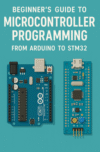When people hear “quantum computing,” they picture massive cryogenic labs, physicists in white coats, and algorithms so abstract they seem more like science fiction than engineering. But what if quantum wasn’t confined to university labs and data centers? What if quantum processors became small, rugged, and cheap enough to sit alongside the microcontrollers inside your smartwatch, your car, or even a drone flying through the forest? That’s the thought experiment worth entertaining: the age of quantum embedded systems.
Right now, embedded development is defined by the balance between power, size, and efficiency. An STM32 or ESP32 can sip milliwatts and deliver just enough processing for IoT connectivity or motor control. But there’s a hard ceiling. Classical embedded processors are forever bound by binary—zeros and ones—and the relentless fight between Moore’s Law and power constraints. Quantum computing, with qubits holding superpositions, suddenly tears open the ceiling. Instead of waiting for a microcontroller to grind through thousands of iterations, a quantum-enabled system could crunch probabilistic answers in parallel.
Imagine an autonomous vehicle with quantum-embedded co-processors running inside its ECU. Today’s cars use a swarm of chips for perception, path planning, and safety checks. A quantum-augmented ECU could simulate thousands of “what if” driving scenarios at once—optimizing not only the safest maneuver but also the most energy-efficient path. Or think about IoT networks, where devices spend endless cycles encrypting and decrypting data. Quantum cryptography hardware could give even the tiniest smart sensor military-grade security without blowing through its power budget.
Of course, quantum hardware today is laughably far from being “embedded.” Qubits need to be cooled near absolute zero, and they decohere faster than a human blink. But here’s the catch—so did early computers. The ENIAC filled a room and consumed kilowatts just to do basic math, and now we have Raspberry Pi-sized boards running Linux on a few dollars of silicon. Every technology that seemed absurdly impractical at birth eventually miniaturized. If quantum coherence can be stabilized in solid-state chips or even room-temperature materials, then nothing stops us from imagining a future where a Jetson Orin Nano has a quantum sibling.
The impact on robotics and edge AI would be explosive. Training AI models locally could shift from days to minutes. A warehouse robot wouldn’t need to ping the cloud to solve optimization problems—it could balance real-time navigation and task scheduling with quantum speed. Even wearables could change: a medical patch might run quantum-assisted simulations of your heart rhythms, predicting anomalies before they manifest.
There will be challenges that mirror today’s embedded struggles. Developers will need quantum-aware programming models just like they once had to learn real-time operating systems. Toolchains, debuggers, and SDKs would evolve to hide the physics and expose useful abstractions. And yes, just like the ARM vs. RISC-V debates today, the industry would argue about whose qubit design is “open” and whose is “proprietary.”
Quantum embedded computers are not around the corner, but they’re not unthinkable either. The semiconductor world thrives on improbable progress. Thirty years ago, the idea of Wi-Fi on a $2 microcontroller would have sounded delusional, yet here we are flashing ESP32s for weekend projects. Someday, maybe not in five years but in fifty, we’ll look back at today’s cryogenic monstrosities and laugh at how “impractical” quantum once seemed. And maybe by then, your drone, your pacemaker, or your refrigerator will quietly be running on qubits.



